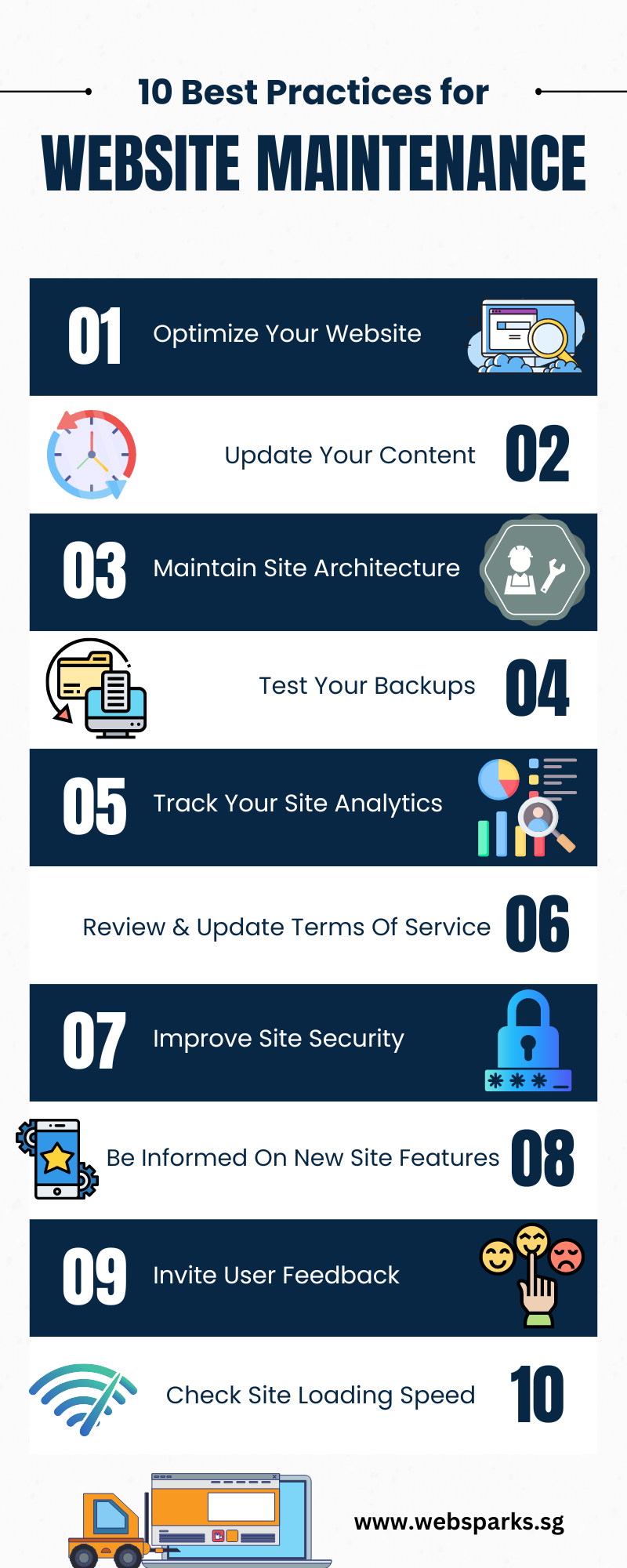In today’s digital age, website maintenance becomes even more crucial where websites are expected to function seamlessly and reliably.
Website maintenance ensures that your website performs optimally with problems addressed regularly.
The problem with websites is that even after years of operation, they can still fall prey to unforeseen issues and breakdowns.
If your site isn’t optimized to perform consistently, you could lose potential customers before they ever reach your landing page.
Most people assume that the way to run an online business is to launch a website and let it sit there. Running new campaigns becomes a priority over maintaining the website.
Eventually, you have to admit that you cannot neglect the importance of website maintenance.
If you’re thinking about why your website isn’t bringing in customers, it’s time to follow the following ten best practices to give your website an overhaul.
10 Best Website Maintenance Practices

1. Optimize Your Website
Optimizing your website for conversions requires you to think about both what people should see, and what people should do.
You need to ask yourself: How am I trying to communicate with my audience, and how can I improve the way I communicate?
Is there anything I can do to ensure the person looking at my site is going to know exactly what to do, or that they won’t just end up confused?
Once you’ve decided to optimize, you need to be careful that the changes you make don’t break the overall design of your website.
If your site is optimized for conversion, it means that your users will have a better experience and a higher chance of purchasing your product or taking up your services.
When optimizing your site for conversion, make sure that all parts of it are working in sync. This includes both the technical and visual aspects.
Make sure that all elements of your site are functioning with one another.
2. Update Your Content
Content updates have a direct impact on the performance of your web pages.
Content that doesn’t change and remains stagnant is outdated. It’s no longer serving its purpose.
Fresh content is a necessary part of successful content marketing. Fresh content can keep search engines crawling back to your site over and over again to check for updates. This allows you to appear in more search results and gain more visibility.
This means updating your website regularly.
Updating regularly keeps visitors interested and ensures that they return for more. The frequency of updates should be decided upon based on your target audience.
Some people want daily updates, while others may only want updates weekly or monthly. Decide upon a timeframe and stick to it.
Also, remember to add a clear call to action (CTA) at the bottom of each page of your site to ensure that visitors always know what to do next.
3. Maintain Your Site Architecture
After all, you can have the best product on the market, but if no one ever visits your website, no one will ever know you have one.
One of the best ways to ensure that potential customers will visit your website is to make sure the architecture of your site is appealing.
This means that the pages load quickly, and as cleanly as possible and that it’s easy for them to navigate around your site.
Most people will only visit a site for a brief amount of time, so having fast pages and a great design is crucial to your business.
4. Test Your Backups

The primary reason why people don’t back up their data is that they assume that they won’t lose any files.
But that isn’t always the case.
The chances of losing some data can be high.
Every site that offers products or services online should be backed up.
This is important because if your site goes down due to a crash, cyber-attacks, or other unforeseen circumstances, the backup will enable you to get back online quickly.
Backups also make it easier to recover if you experience a catastrophic failure of your web server, for example.
5. Track Your Site Analytics
Analytics can help you analyze site traffic, improve your site, and increase sales.
It provides a great insight into how users are interacting with your website, as well as information about how they’re finding your site.
With this knowledge, you can make informed decisions about where to focus your efforts and where to spend your time optimizing different elements of your website.
6. Review And Update the Terms Of Service
It’s important to update your terms of service whenever you update the site’s code.
You need to be clear and specific about what happens to your users’ data and communications after they log in.
Your users have no reason to trust you if they don’t understand how you will treat their data or protect their privacy.
Also, make sure to clearly state what happens to content uploaded to the site.

7. Improve Site Security
Improving the security of your website is vital against cyberattacks and threats.
The first thing you need to do to prevent your site from being hacked is to install a safe and reliable web hosting service.
You can also protect your site by using a secure password and keeping your login information safe. You also need to update the information about your site in case it has been hacked.
If you do those things, then your customers may feel more assured. You must keep an eye on your site’s logins and passwords.
This will help you identify and fix any problems as soon as possible.
8. Make Sure Your Site Is Informed About New Features
Don’t fall into the trap of thinking you need to update your site every single day or even multiple times a week with new features.
That can be overwhelming, especially if you’re trying to keep up with the competition.
Instead, focus on updates that align with your brand and the stories your audience is interested in.

When people visit your site, you want them to feel welcomed and informed.
If you’re making any kind of change (including changing your logo), make sure to let your users know about it.
On a side note, it’s easy to make the mistake of thinking that new features are just thrown out there to sell you something.
They’re usually developed to improve the user experience. This is why you should always keep track of your site’s metrics, whether it’s conversions, site speed, bounce rate, etc.
Keeping an eye on these will allow you to understand how changes to your site are affecting your audience, making sure that new features are working as expected.
9. Invite User Feedback
How do you get the most value out of your website?
Don’t assume that the users of your site are happy with the experience they’re getting.
Find ways to engage your website’s users and get feedback, both positive and negative, as you’re maintaining your website over time.
10. Check the Loading Speed
Loading time has become increasingly important to users.
The faster a site loads, the better chance you have of being ranked higher in search engines.
This can translate into better conversions.
As Google’s Matt Cutts says, “The faster your site loads, the faster it gets indexed.”
And with over half of smartphone owners using their devices while on the go, the quicker a site can load is imperative to the user experience.
A slow-loading site can be frustrating, distracting, and costly for your business.
Conclusion
Website maintenance is an ongoing process that requires a regular schedule.
When you start planning your website maintenance schedule, there are several key questions you need to answer:
- What type of website maintenance do you need to do regularly?
- Is it enough to just keep the site in working order? Or does it need to be more than that?
- How often should you update your site content to keep up to the changing
The first thing to do is to understand what needs to be done.
If you do not know where to start, you should start following the abovementioned best practices for maintaining your website.
If you find the task of website maintenance too overwhelming for you, consider hiring a website maintenance company.
Read 5 Reasons Why Hire A Website Development Company
Why choose Websparks as your website maintenance company?
Websparks is a full-service web company and agency based in Singapore.
We offer website maintenance services as well as website support, website development, and web design services.
Websparks believes in offering holistic and value-for-money services, providing high reliability and instant support required by our clients.
Many existing clients attest to our high levels of web and application maintenance services with high accolades and contract renewals.
Consult our experts to realize and maintain your websites.
Find out more about our services.






